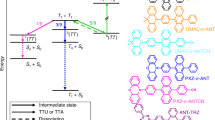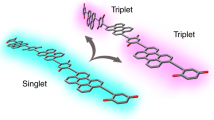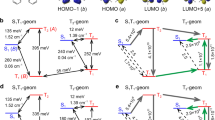Abstract
Jortner, Rice, Katz and Choi have recently shown that triplet–triplet annihilation leading to delayed fluorescence in crystalline anthracene can be adequately described in terms of a random walk diffusion model when the effects of charge transfer interactions are included1. This model is valid if the scattering of the triplet excitation wave by lattice phonons is so strong that the mean free path of the triplet exciton is of the same order of magnitude as the crystal lattice spacing. On the basis of the random walk model the triplet–triplet interaction rate constant (γ) is given by  where D is the triplet excitation diffusion constant and R is the triplet–triplet interaction distance, taken to be 10−7 cm for crystalline anthracene2. The value of γ calculated by Jortner et al. for anthracene is 4 × 10−11/cm3/sec, and is in good agreement with the experimental values2 which range from 1 × 10−11 to 5 × 10−11/cm3/sec. (Moore and Munro3 have recently reported γ = 2.1 × 10−11/cm3/sec for a carefully purified anthracene crystal.) The value of D calculated using equation (1) is 30 × 10−6/cm2/sec which shows quite good agreement with the value of 6 × 10−6/cm2/sec obtained by King and Voltz2. (In calculating the value of D, Jortner et al.1 assume a pure anthracene crystal; King and Voltz2, however, analysed the slow scintillation component obtained from anthracene crystals of commercial grade. They suggest that the ionizing radiation may perturb the crystal lattice, thus giving a value of D which may be different from diffusion in the perfect lattice.)
where D is the triplet excitation diffusion constant and R is the triplet–triplet interaction distance, taken to be 10−7 cm for crystalline anthracene2. The value of γ calculated by Jortner et al. for anthracene is 4 × 10−11/cm3/sec, and is in good agreement with the experimental values2 which range from 1 × 10−11 to 5 × 10−11/cm3/sec. (Moore and Munro3 have recently reported γ = 2.1 × 10−11/cm3/sec for a carefully purified anthracene crystal.) The value of D calculated using equation (1) is 30 × 10−6/cm2/sec which shows quite good agreement with the value of 6 × 10−6/cm2/sec obtained by King and Voltz2. (In calculating the value of D, Jortner et al.1 assume a pure anthracene crystal; King and Voltz2, however, analysed the slow scintillation component obtained from anthracene crystals of commercial grade. They suggest that the ionizing radiation may perturb the crystal lattice, thus giving a value of D which may be different from diffusion in the perfect lattice.)
This is a preview of subscription content, access via your institution
Access options
Subscribe to this journal
Receive 51 print issues and online access
$199.00 per year
only $3.90 per issue
Buy this article
- Purchase on Springer Link
- Instant access to full article PDF
Prices may be subject to local taxes which are calculated during checkout
Similar content being viewed by others
References
Jortner, J., Rice, S. A., Katz, J. L., and Choi, S-I., J. Chem. Phys., 42, 309 (1965).
King, T. A., and Voltz, R., Proc. Roy. Soc., A, 289, 424 (1966).
Moore, G. F., and Munro, I. H., Nature, 208, 772 (1965).
Kepler, R. G., Caris, J. C., Avakian, P., and Abramson, E., Phys. Rev. Lett., 10, 400 (1963).
Avakian, P., and Merrifield, R. E., Phys. Rev. Lett., 13, 541 (1964).
Medinger, T., and Wilkinson, F., Trans. Faraday Soc., 61, 620 (1965).
Birks, J. B., The Theory and Practice of Scintillation Counting, 218 (Pergamon Press, 1964).
Singh, S., Jones, W. J., Siebrand, W., Stoiecheff, B. P., and Schneider, W. G., J. Chem. Phys., 42, 330 (1965).
Author information
Authors and Affiliations
Rights and permissions
About this article
Cite this article
MOORE, G. Effect of Temperature on the Triplet–Triplet Annihilation Rate in Anthracene Crystals. Nature 211, 1170–1171 (1966). https://doi.org/10.1038/2111170b0
Issue Date:
DOI: https://doi.org/10.1038/2111170b0
Comments
By submitting a comment you agree to abide by our Terms and Community Guidelines. If you find something abusive or that does not comply with our terms or guidelines please flag it as inappropriate.



